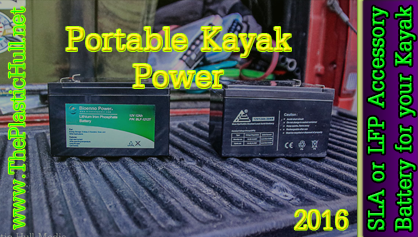
SLA or LFP Accessory Battery for your Kayak
 In a short period of time Fishing kayaks in most cases a single user vessel have begun using many of the electronics that power boats use. Portable power has become a necessity. Running Fish Finders on a battery pack of AA batteries is a thing of the past. In the present we have Fish Finder/Chart Plotter combos, kayak lighting, and the ability to charge battery powered devices while away from home is important.
In a short period of time Fishing kayaks in most cases a single user vessel have begun using many of the electronics that power boats use. Portable power has become a necessity. Running Fish Finders on a battery pack of AA batteries is a thing of the past. In the present we have Fish Finder/Chart Plotter combos, kayak lighting, and the ability to charge battery powered devices while away from home is important.
Previously we built a waterproof battery box for a fish-finder/chart plotter. Since then there have been many advancements in batteries. This article explains the difference between the traditional Sealed Lead Acid Battery (SLA) and the latest Lithium-iron-phosphate battery (LFP). Here I list the pros and cons of both. You make the decision!
A SLA battery
SLA Battery Pros:
- Inexpensive (Economically Friendly)
- Fully Sealed Package
- Rechargeable
- Recyclable
SLA Battery Cons:
- Poor weight-to-energy (8 lbs 12aH)
- Cannot be stored in a discharged condition
- Inconstant discharge voltage
- Limited number of full discharge cycles
- Lifespan (300 charge cycles)
- Sulfation
- Memory
- Not Environmentally Friendly
- Contains Lead
 There are many cons to the SLA battery for use on a kayak the first being weight. The 12aH SLA will weigh in at 8 lbs. That’s a lot of weight to travel with on any kayak. Battery life is another issue you may get a season or two total out of the lifespan.
There are many cons to the SLA battery for use on a kayak the first being weight. The 12aH SLA will weigh in at 8 lbs. That’s a lot of weight to travel with on any kayak. Battery life is another issue you may get a season or two total out of the lifespan.
New and improved Lithium-iron-phosphate batteries (LiFePO4 or LFP) are slowly replacing Traditional SLA batteries. Although still pricey LFP batteries have many advantages over the previous generation technology of SLA’s.
LFP Battery Pros:
- Excellent Weight-to-energy (3.5 lbs 12aH)
- Very constant discharge voltage
- Low Discharge Rate compared to SLA
- Rechargeable
- No Memory (Can Be fully Discharged without cell damage)
- Lifespan (2000+ charge cycles 5-10+ years)
- Recyclable
- Thermal and chemical stable aka Safer (as opposed to Lithium Ion cells)
- No Environmental Thermal concerns (provides maximum output at hot or cold temps)
LiFePO4 Battery Cons:
- Cost (Expensive)
- Contains Phosphates
Looking forward to this conversion. Will report on the experience in the near future.



